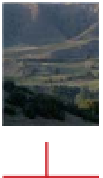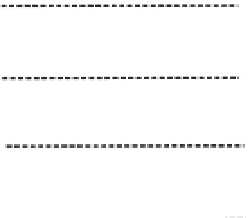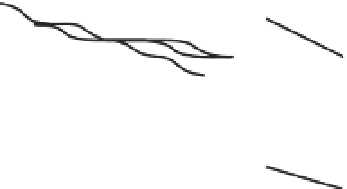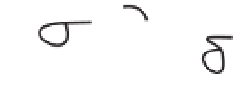Geology Reference
In-Depth Information
(termed
augen
), thus mimicking the
shape of the strain ellipsoid, and can be
used as strain markers (
see
Chapter 4).
Banded gneisses, of broadly gran-
itic composition, are a common com-
ponent of Precambrian basement
complexes and have been the subject
of much debate in the past, when
many were thought to be 'granitised'
metasediments. Banding, on a scale of
centimetres, invites comparison with
metasedimentary rocks, and close
inspection of the nature of the banding,
and of the chemical composition of the
gneisses, is often necessary to establish
their origin. Intense deformation in
deep-crustal shear zones (
see
Figure
6.12) can be shown to transform ori-
ginally homogeneous granites, cut by
quartzo-feldspathic veins, into banded
gneiss, as in the example shown in
Figure 7.3D, and there is no doubt
now that most granitic gneiss com-
plexes are in fact igneous, rather than
chemically altered metasediments.
Extensional crenulation cleavage
('ecc structure')
This type of fabric consists of a crenu-
lation cleavage that is oblique to the
trend of the main foliation, in such a
way that tthe smaller angle between
the two sets of planes opens towards
the direction of shear (Figure 7.4A).
The crenulations are asymmetric open
microfolds (i.e. with a large fold angle)
whose long limbs have been thinned
and extended, hence the extensional
nature of the cleavage. The sense of
shear on the crenulation cleavage is
the same as the overall shear sense. Ecc
structure is typical of slates, phyllites
and schists that have been subjected
to relatively low degrees of shear strain
in a later deformation, and therefore
the axes of the crenulations are usually
perpendicular to the shear direction.
ecc
S
7
A
S
60
61
C
B
S
C´
C
1
2
D
E
3
4
F
G
S-C structure
This type of structure consists of two
sets of planes - the 'S planes', which are
the main foliation, and the 'C planes',
which are a set of shear planes arranged
obliquely to the main foliation (Figure
7.4B, 7.5B). As with ecc structure, the
C planes have the same shear sense
as the main shear zone, and the acute
angle between the two foliations opens
towards the shear direction. Unlike ecc
structure, however, the C planes may
be widely or irregularly spaced and
may be either shear faults or narrow
shears. S-C structure is common in
foliated fault gouge (
see
Figure 5.9A)
and may be used to determine the
direction of movement on the fault. In
schists and gneisses, deformed under
higher temperatures, the C planes
correspond to narrow shear zones. In
that case, both fabrics may result from
Figure 7.4
Asymmetric fabrics, rotation and
sense of shear.
A.
Extensional crenulation
cleavage (ecc structure): the cleavage bands
(in orange), which have been extended and
thinned, act as sinistral shears (ecc) at an acute
angle to the schistosity (S).
B.
S-C structure:
The schistosity (S), which is inclined to the right,
is cut by sinistral shears (C, in red) which are
parallel to the main shear zone.
C.
Antithetic
shears: the red lines (C´) are antithetic dextral
shears at a high angle to the main (sinistral)
shear zone.
D.
Sigma structure: the orange
blob is a hard object such as a porphyroblast
enclosed in schist or mylonite subjected to
dextral shear, whose effect is to form a 'tail' of
recrystallised small grains at the top and bottom
sides of the object, pointing towards the shear
direction; the top half of this structure looks like
the Greek letter sigma (
V
).
E.
Delta structure: if
the sigma structure is rotated under continued
dextral shear, the structure ultimately resembles
an inverted Greek letter delta (
G
).
F
,
G
, rotated
porphyroblast with internal fabric: F. the internal
fabric within the porphyroblast (e.g. a garnet)
indicates the (dextral) sense of shear. In G, the
garnet has continued to grow during rotation,
producing a curved shape in the internal fabric
that indicates the sense of shear.
Fabric asymmetry and shear
sense
Certain fabrics possess an asymmetry
that indicates the direction of shear
strain (the
shear sense
) of the defor-
mation responsible for creating them;
for example, distinguishing sinistral
from dextral shear. Such fabrics gener-
ally consist of two non-parallel sets
of planar elements that are oblique
to each other - hence the asymme-
try - but may also include objects
that have been deformed or rotated
in the same sense as the shear strain.
Asymmetric fabrics are particularly
useful in determining the shear direc-
tion of shear zones, and are known
as
sense-of-movement criteria
.











































Search WWH ::

Custom Search